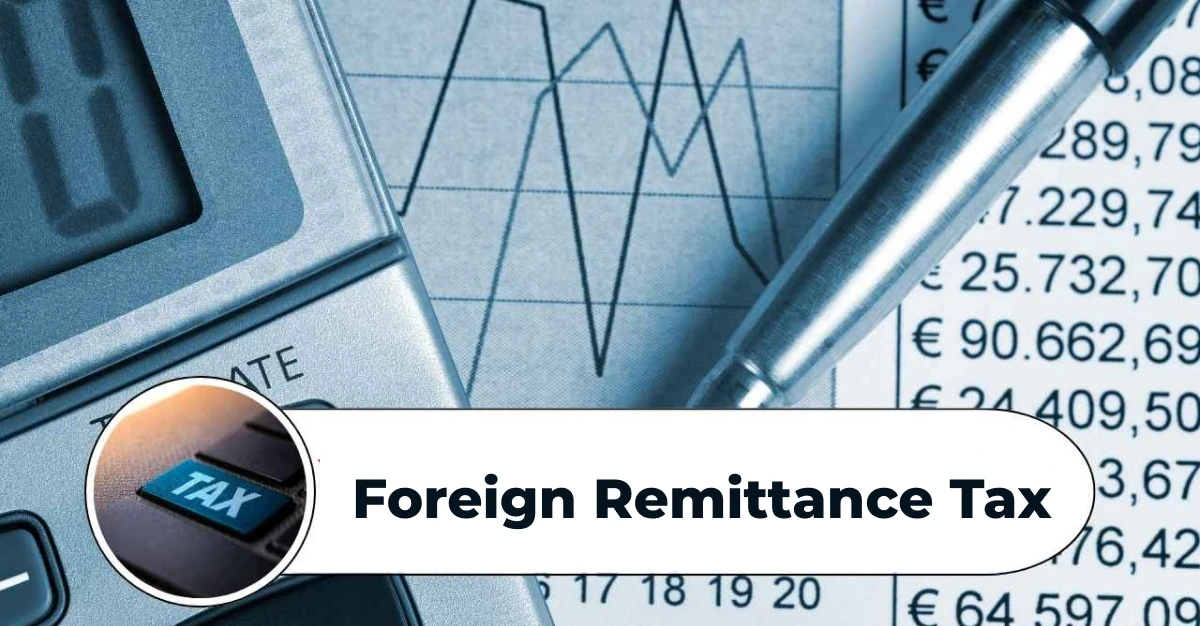Have you ever wondered about that extra chunk of money disappearing when you send cash across borders? It’s called the Foreign Remittance Tax, and it’s worth knowing about. Whether you’re sending money to family or paying for services abroad, that tax can eat into your hard-earned cash.

But fear not!
There are ways to minimize its impact. In this guide, we’ll explore what exactly the Foreign Remittance Tax is and some effective strategies to reduce it.
So, if you’re keen to hold onto more of your money when sending it overseas, stick to this write-up without skipping a single part!
(A) Understanding Foreign Remittance Tax

First and foremost, let’s get a grip on what Foreign Remittance Tax means because it directly impacts how much money you get to keep when sending cash abroad.
(A.1) What is Foreign Remittance Tax?
Foreign Remittance Tax, often referred to as a remittance fee or transfer tax, is a levy imposed by governments on money sent from one country to another.
Let me explain it in simple terms.
When you send money from one country to another, sometimes a portion of that money gets taxed. Yep, it’s like a fee for sending money across borders. This tax can vary depending on where you’re sending money to and from, and the amount you’re sending. Basically, it’s a way for governments to keep track of money moving in and out of their country.
Transfers of money from abroad play a significant role in boosting our nation’s GDP and promoting overall economic development.
In India, remittances sent or received are liable to be taxed through TCS (tax collected at source). Notably, the Central Government has implemented recent revisions to taxation regulations concerning remittances within India. We will discuss it in detail in the upcoming sections.
(A.2) What constitutes foreign remittance?
Well, foreign remittance includes any funds sent by individuals or businesses across international borders for various purposes. Let me give you a thorough breakdown of it-
| Type of Remittance | Description |
| Personal Transfers | Money sent by individuals to family members, friends, or others for personal reasons, such as living expenses, gifts, or support. |
| Business Transactions | Funds transferred by businesses or organizations for various purposes, including payments for goods or services, investments, or operational expenses. |
| Salary and Wages (Getting paid from abroad) | Payments made by employers to employees working abroad, including salaries, wages, bonuses, and other forms of compensation. |
| Investment Returns (Making money from investments) | Profits, dividends, interest, or other financial gains earned by individuals or entities from investments made in foreign assets or ventures. |
| Repatriation of Funds (Bringing profits home) | Transfer of profits, capital, or earnings earned abroad by foreign companies, expatriates, or investors back to their home country. |
| Foreign Aid (Helping out in other countries) | Financial assistance provided by governments, organizations, or individuals to foreign countries or communities for development, relief, or humanitarian purposes. The tax imposed on foreign aid helps the government to track the money. |
Understanding how money moves across borders helps you see why it’s important to know about foreign remittances.
(A.3) Exemptions from Foreign Remittance Tax
Are all the funds going outside or inside a country taxed? You may ask. Well, not really! Certain types of remittances are exempted from foreign remittance tax. Here are those-
| Exemption | Reasons |
| Inheritance | Inherited funds are considered capital receipts and not taxable. |
| Foreign education expenses | Educational expenses are essential and exempt from tax. |
| Foreign medical expenses | Medical expenses are necessary and not subject to tax. |
| Foreign travel expenses | Travel expenses are personal and exempt from tax. |
| Foreign donations to charitable organizations | Donations to foreign charities promote social welfare and are tax-exempt. |
You may find some of the exemptions overlapping with the funds that are taxed under foreign remittance. These tax regulations vary from country to country. So, if you are looking for tax on foreign remittances in a certain country, you need to consult the local tax authorities or tax professionals for specific guidance.
In the next section, we will discuss the foreign remittance tax regulations in our country.
(B) Foreign Remittance Tax Regulation in India
In the 2023 budget announcement, Finance Minister Smt. Nirmala Sitharaman revealed some significant changes regarding foreign remittance taxes. Now, under the Liberalised Remittance Scheme (LRS), the tax collected at source (TCS) rate has been bumped up from 5% to 20%. This adjustment came into effect starting October 2023–
| Category | Threshold | TCS Rate | Details |
| Education | Up to Rs.7 lakhs | 0% | Foreign remittance up to Rs.7 lakhs for education is exempt from TCS. |
| Exceeding Rs.7 lakhs (Paid via Loan) | 0.5% | Amount exceeding Rs.7 lakhs, paid via a loan from an authorized financial institution, is subject to a TCS of 0.5%. | |
| Exceeding Rs.7 lakhs | 5% | Remittances exceeding Rs.7 lakhs spent on foreign education are subject to a TCS rate of 5%. | |
| Travel expenses exceeding | 5% | Amount spent on traveling for foreign education exceeding Rs.7 lakhs is subject to a TCS rate of 5%. | |
| Medical Expenses | Exceeding Rs.7 lakhs | 5% | Foreign remittance made for medical expenditure exceeding Rs. 7 lakhs attracts a TCS rate of 5%. |
| Travel Expenses exceeding Rs.7 lakh | 5% | Remittances made for foreign travel for medical treatment exceeding Rs. 7 lakhs are taxed at a TCS rate of 5%. | |
| Overseas Tour Packages | Below Rs.7 lakhs | 5% | Any overseas tour package incurring costs below Rs.7 lakhs is taxed at a TCS rate of 5%. |
| Exceeding Rs.7 lakhs | 20% | Tour packages costing more than Rs.7 lakhs incur a TCS rate of 20%. | |
| Foreign Investments | Total investment exceeding Rs.7 lakhs | 20% | Taxpayers investing in foreign stocks, cryptos, or mutual funds exceeding Rs.7 lakhs during the year face a TCS rate of 20%. |
| Mutual funds investing in foreign stocks | 0% | Investments in Indian mutual funds dealing in foreign stocks are not considered foreign remittances and are not taxable under LRS. | |
| Tax on Debit and Credit | Exceeding Rs.7 lakhs | 20% | Payments made using Forex cards and debit cards exceeding Rs. 7 lakhs are subject to a TCS rate of 20%. |
| Credit | 0% | Payments by credit card are not under LRS and are not subject to TCS. |
Now, let me wind up the exceptions to the TCS rule that came into effect in October 2023. When you send money abroad to cover educational expenses, you get some leeway. Up to a maximum of Rs. 7 lakhs, you’re in the clear from TCS.
But, if you’re sending more than that and it’s funded by a loan, you’ll face a 0.5% TCS charge. Now, if the expenses are covered by other income sources, a 5% TCS applies beyond the maximum threshold.
And watch out, if you can’t prove that the funds are for educational purposes, the TCS rate jumps to 20%. Plus, not having a PAN card can hike up the TCS rates even more. For education loan-funded transfers exceeding the cap, the TCS rate rises to 5%, and for regular income sources, it increases to 10%.
Similarly, when it comes to medical expenses, you’ve got a bit of breathing room. Up to Rs. 7 lakhs, no TCS. But if you go over that, expect a 0.5% TCS charge.
While the rates of TCS on foreign remittances have gone up, there are still ways you can save on taxes for your foreign remittances, tours, and more. With careful planning and a good understanding of taxes, you can make the most of your tax savings.
(C) Factors influencing foreign remittance tax rates
Understanding the factors that shape foreign remittance tax rates is essential for you to navigate cross-border transactions efficiently. So here are those-
| Factors | Description |
| Government Policies | Tax rates on foreign remittances are influenced by government policies and regulations. These policies may change over time based on economic conditions and objectives. |
| Economic Conditions | The state of the economy, including factors like inflation, exchange rates, and GDP growth, can impact foreign remittance tax rates as governments adjust fiscal policies. |
| International Relations | Diplomatic relations and agreements between countries may affect foreign remittance tax rates, especially in the context of tax treaties and bilateral agreements. |
| Purpose of Remittance | The purpose for which the remittance is being sent, such as education, medical expenses, or investment, may influence the tax rates applied to the transaction. |
| Tax Treaties and Agreements | Countries may have tax treaties or agreements in place to avoid double taxation on foreign remittances, which can affect the tax rates applicable to cross-border transfers. |
| Domestic Tax Laws | Domestic tax laws and regulations, including provisions related to TDS (tax deducted at source) and TCS (tax collected at source), can determine the tax rates on foreign remittances. |
| Compliance and Reporting | Compliance requirements and reporting obligations imposed by regulatory authorities may influence foreign remittance tax rates, ensuring transparency and accountability. |
| Economic Development Goals | Tax rates on foreign remittances may align with government objectives related to economic development, poverty alleviation, or encouraging investments in specific sectors. |
Note: When it comes to taxes, the Pink tax has been trending recently. Do you know about Pink Tax? If not, visit the article “What is Pink Tax? How does it impact women?” for detailed information.
(D) Reasons for reducing foreign remittance tax
The following reasons describe why lowering the foreign remittance tax can be good for you-
| Reasons | Description |
| Economic Growth | Lowering remittance tax boosts the economy by increasing cross-border transactions. |
| Financial Access | Reducing tax makes it easier for families to receive money from abroad, especially in poorer areas. |
| Poverty Reduction | Less tax means more money reaches families in need, helping to reduce poverty. |
| Economic Development | Lower taxes attract more investments, aiding overall economic progress. |
| Market Competition | Lowering taxes encourages better services and lower fees in the remittance market. |
| Humanitarian Aid | Lower tax ensures more funds are available for emergency relief efforts. |
| Diaspora Engagement | Lower taxes encourage more involvement from overseas communities. |
| Global Competitiveness | Reduced taxes attract more foreign workers and businesses, boosting competitiveness. |
(E) Strategies to reduce foreign remittance tax
Here comes the most anticipated part of the write-up. The following points describe some of the most efficient ways to reduce foreign remittance tax in India-
(E.1) Utilizing Tax Treaties
Did you know that some countries have special agreements called tax treaties? These treaties help prevent double taxation on the same income. So, if you’re sending money from a country with a tax treaty to another country, you might be able to avoid paying taxes twice on the same amount.
Let’s say you’re sending money from the USA to India, and both countries have a tax treaty in place. You might only have to pay taxes in one of the countries instead of both, which can significantly reduce your tax burden.
(E.2) Opting for Exempt Categories
Sometimes, certain types of transactions are exempt from foreign remittance tax. These can include gifts, donations, or money spent on education. By using these exempt categories, you can minimize or even avoid paying taxes on your remittances altogether.
If you’re sending money to your family in India for your nephew’s education, you might not have to pay any taxes on that transfer if it falls under the exempt category for educational expenses.
(E.3) Timing of Transactions

Did you know that the timing of your remittance transactions can affect how much tax you have to pay? Sometimes, tax rates might be lower during certain periods, or there could be tax holidays or exemptions. By timing your transfers strategically, you can reduce your overall tax burden.
If you know that tax rates are lower at the beginning of the year, you might choose to send a larger remittance then to take advantage of the lower rates and save on taxes.
(E.4) Utilizing Deductions
Just like with your income taxes, there might be deductions or credits available that can lower the taxable amount of your foreign remittances. By utilizing these deductions, you can reduce the amount of tax you owe on your transfers.
Some countries allow deductions for specific types of expenses, such as medical costs or charitable donations. By keeping track of these expenses and deducting them from your remittance amount, you can lower your taxable income and pay less tax.
(E.5) Structuring Transactions
Smartly structuring your remittance transactions can also help minimize taxes. This could mean spreading out your transfers over time or using tax-efficient financial instruments to make your transfers.
Instead of sending one large lump sum, you might choose to send smaller amounts over several months. This can help you stay below certain tax thresholds and reduce the overall tax you owe on your transfers.
(E.6) Seeking Professional Advice

When in doubt, it’s always a good idea to seek advice from tax professionals or financial advisors. They can help you navigate the complex world of foreign remittance taxes and identify opportunities to minimize your tax liabilities.
If you’re unsure about which strategy is best for your situation, consulting with a tax advisor can provide valuable insights tailored to your specific circumstances, helping you make informed decisions and maximize your tax savings.
(E.7) Utilizing Special Investment Vehicles
Some countries offer special investment vehicles or schemes that provide tax benefits for foreign remittances. These could include government-sponsored investment programs or designated investment funds that offer tax breaks or exemptions.
Investing in a government-approved foreign investment fund that offers tax incentives for foreign remittances can help reduce your overall tax liability on your transfers.
(E.8) Leveraging Currency Exchange Rates
Taking advantage of favorable currency exchange rates can help maximize the value of your remittances and minimize the tax impact. By converting your money at the right time or using currency exchange strategies, you can optimize your remittance amounts and reduce tax exposure.
Monitoring currency exchange rates and converting your money when the exchange rate is favorable can help you get more value for your remittance, effectively reducing the taxable amount.
(E.9) Utilizing Trusts or Holding Companies

Setting up trusts or holding companies in tax-friendly jurisdictions can help mitigate foreign remittance tax liabilities. By structuring your transfers through these entities, you may be able to take advantage of favorable tax treatment and lower tax rates.
Establishing a trust in a jurisdiction with favorable tax laws for foreign remittances and routing your transfers through the trust can help minimize taxes on your remittance transactions.
(E.10) Engaging in Tax Planning Strategies
Engaging in proactive tax planning can help optimize your foreign remittance tax situation. This could involve strategic timing of transactions, utilizing tax-efficient investment strategies, or structuring your finances in a way that minimizes tax exposure.
Working with tax advisors to develop a comprehensive tax planning strategy that considers your financial goals and circumstances can help identify opportunities to minimize taxes on your foreign remittances.
(E.11) Use Alternative Payment Methods
You need to explore some alternative payment methods that may have lower tax implications. For example-
- International Credit Cards: Using credit cards for foreign expenses can sometimes offer better exchange rates and lower fees compared to traditional bank transfers.
- Online Payment Platforms: Investigate online platforms that specialize in international money transfers. These platforms may offer competitive rates and reduced fees.
From May 16, 2023, international credit card payments fall under LRS, subject to an annual limit of $250,000. In other words, LRS (Liberalised Remittance Scheme) allows Indian residents to send up to $250,000 per fiscal year abroad for certain transactions. Additional remittance requires RBI approval.
Some International credit cards that can help you save foreign remittance tax are-
- American Express Platinum Travel Card
- HDFC Bank Regalia Credit Card
- Axis Bank Miles & More World Credit Card
- ICICI Bank Sapphiro Credit Card
- Standard Chartered Priority Visa Infinite Credit Card
Here, we would suggest that you should consult with your bank or financial advisor for personalized advice based on your situation.
(F) Final Thoughts
In wrapping up our discussion on foreign remittance tax, it is crucial to equip yourself with effective strategies to minimize your tax burden. By taking strategic steps, you can mitigate the tax burden effectively. From understanding tax treaties to exploring exemption categories and timing transactions wisely, there are several options to explore.
Seeking advice from tax professionals can provide valuable insights tailored to your specific situation. Additionally, considering deductions, optimizing transaction structures, and exploring alternative payment methods can further alleviate tax concerns.
By putting these strategies into action, you’ll find yourself confidently navigating foreign remittance tax, leading to smoother transactions and improved financial outcomes!


Understanding about foreign remittance tax is crucial when dealing with money matters across the boundaries!